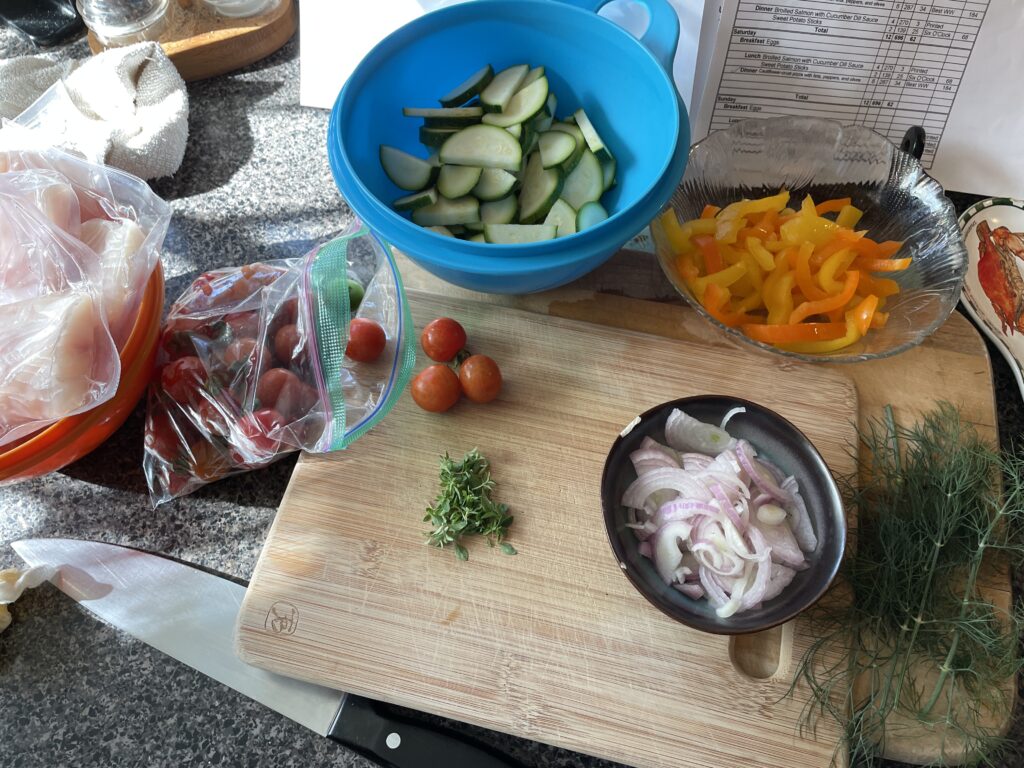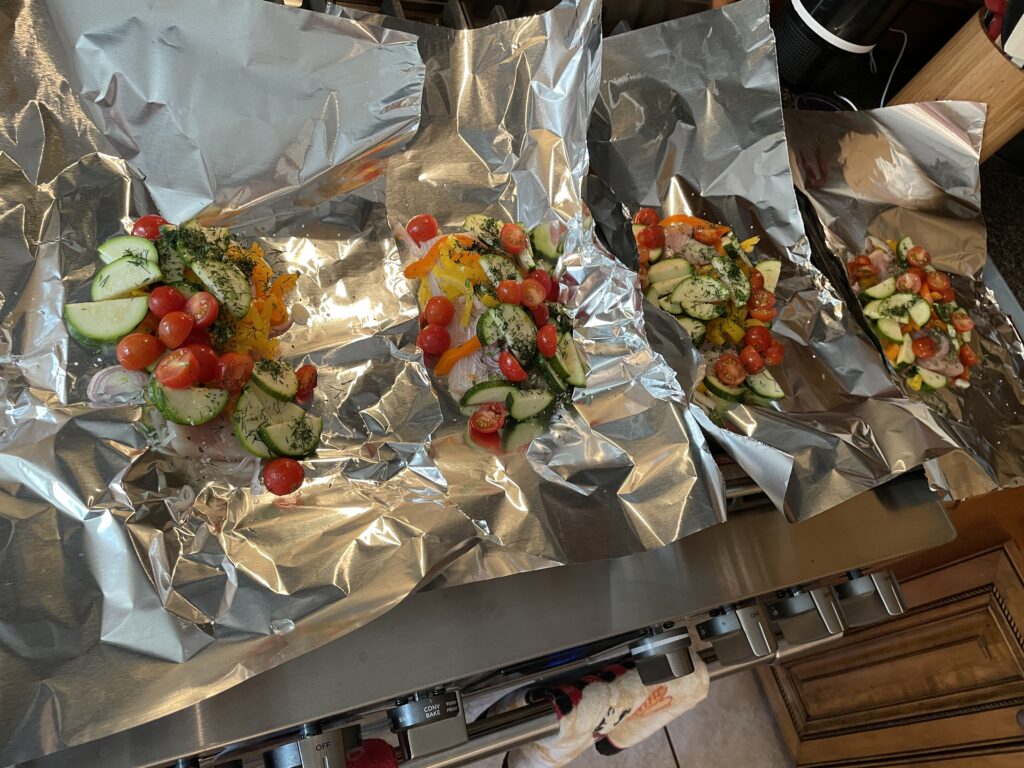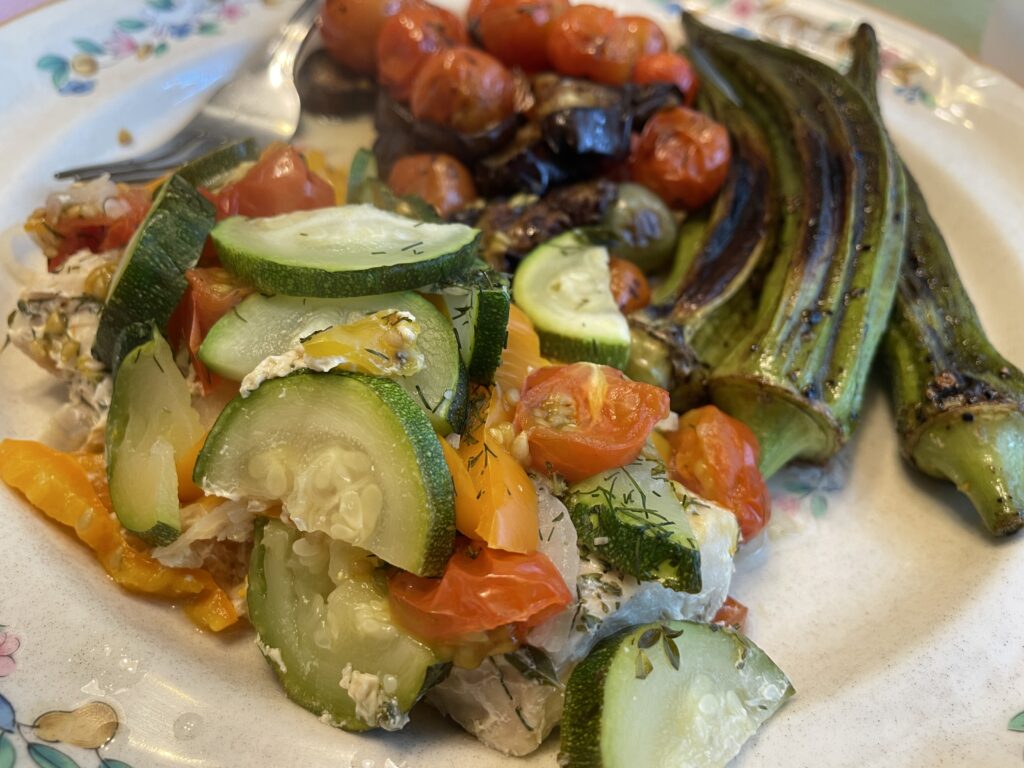Points: 0 ~ Prep Time: 20 minutes ~ Cook time: 15 minutes ~ Serves: 4
This recipe was inspired by the WW recipe for Seasoned red snapper baked in packets. The ingredients for my version of the recipe are displayed in the image below. Homegrown cherry tomatoes, fresh zucchini, yellow and orange bell peppers, shallots, thyme, dill, and mahi mahi filets.
Baking fish in foil pouches is a fantastic way to infuse flavors and ensure a moist and tender result. In this recipe, we’ll be preparing delicious mahi mahi fillets enveloped in a packet with a medley of fresh herbs and vegetables. The foil pouches help to seal in all the goodness, creating a delightful and healthy dish. Let’s dive in!
Ingredients
- 4 8-ounce skinless mahi mahi filets
- 24 medium cherry tomatoes, halved
- 1 medium zucchini, sliced into 1/2 moons
- 1 medium yellow bell pepper, sliced
- 1 medium shallot, thinly sliced
- 2 teaspoons fresh dill, chopped
- 2 teaspoons fresh thyme, chopped
- 1/2 teaspoon garlic salt
- 1/4 teaspoon fresh cracked black pepper
Procedure Steps
- Preheat oven to 400° F. Pull out 4 12-inch wide sheets of aluminum foil and place on a sheet pan.
- Place fish filet in the center of each foil piece and top with an evenly divided amount of the remaining ingredients as listed above. For example, each mahi mahi filet gets 12 cherry tomato halves, 1/4 of the zucchini slices, and so on. Fold the foil for a tightly sealed packet. Place the packets on the sheet pan an into the oven for 15- to 20-minutes or so until the fish is cooked through. Let stand at room temperature for 5-minutes before opening the packets, being careful of any escaping steam. Yield is 1 filet and about 1-cup of vegetables per serving.
Background on Mahi Mahi:
Mahi mahi, also known as dolphin fish or dorado, is a popular fish known for its vibrant colors, firm texture, and mild, slightly sweet flavor. Despite its name, mahi mahi is not related to dolphins; it is a species of fish found in warm ocean waters around the world. Mahi mahi is highly sought after by anglers for its sport fishing qualities, and it is also a popular choice for seafood lovers due to its delicious taste and versatility in cooking.
Sources of Mahi Mahi:
- Wild-Caught: Mahi mahi is primarily a wild-caught fish, with most of the commercial supply coming from the Atlantic Ocean, particularly off the coasts of Florida, the Caribbean, and the Gulf of Mexico. It is also found in other warm waters, including the Pacific Ocean near Central and South America, Hawaii, and Southeast Asia.
- Sustainable Fishing: Mahi mahi is considered a sustainable seafood choice. It has a relatively fast growth rate and abundant population, which helps maintain healthy stocks. However, it’s essential to ensure that the fish is sourced from well-managed fisheries that employ responsible fishing practices to minimize bycatch and protect the marine ecosystem.
- Aquaculture: While mahi mahi is primarily a wild-caught fish, there have been some efforts to develop aquaculture methods for its production. However, at present, the majority of mahi mahi available in the market is still sourced from wild fisheries.
- Seasonality: Mahi mahi is available year-round, although there may be slight variations in availability depending on the region. It’s always a good practice to check with your local fish market or seafood supplier to ensure the freshest and most sustainably sourced mahi mahi.
When purchasing mahi mahi, look for firm, moist flesh with a mild aroma of the sea. Fresh mahi mahi should have a vibrant appearance, with skin ranging from blue-green to gold. If frozen, make sure it has been properly stored and thawed before cooking to maintain its quality.
By understanding the sources and sustainability of mahi mahi, we can make informed choices to enjoy this delicious fish while supporting responsible fishing practices.














